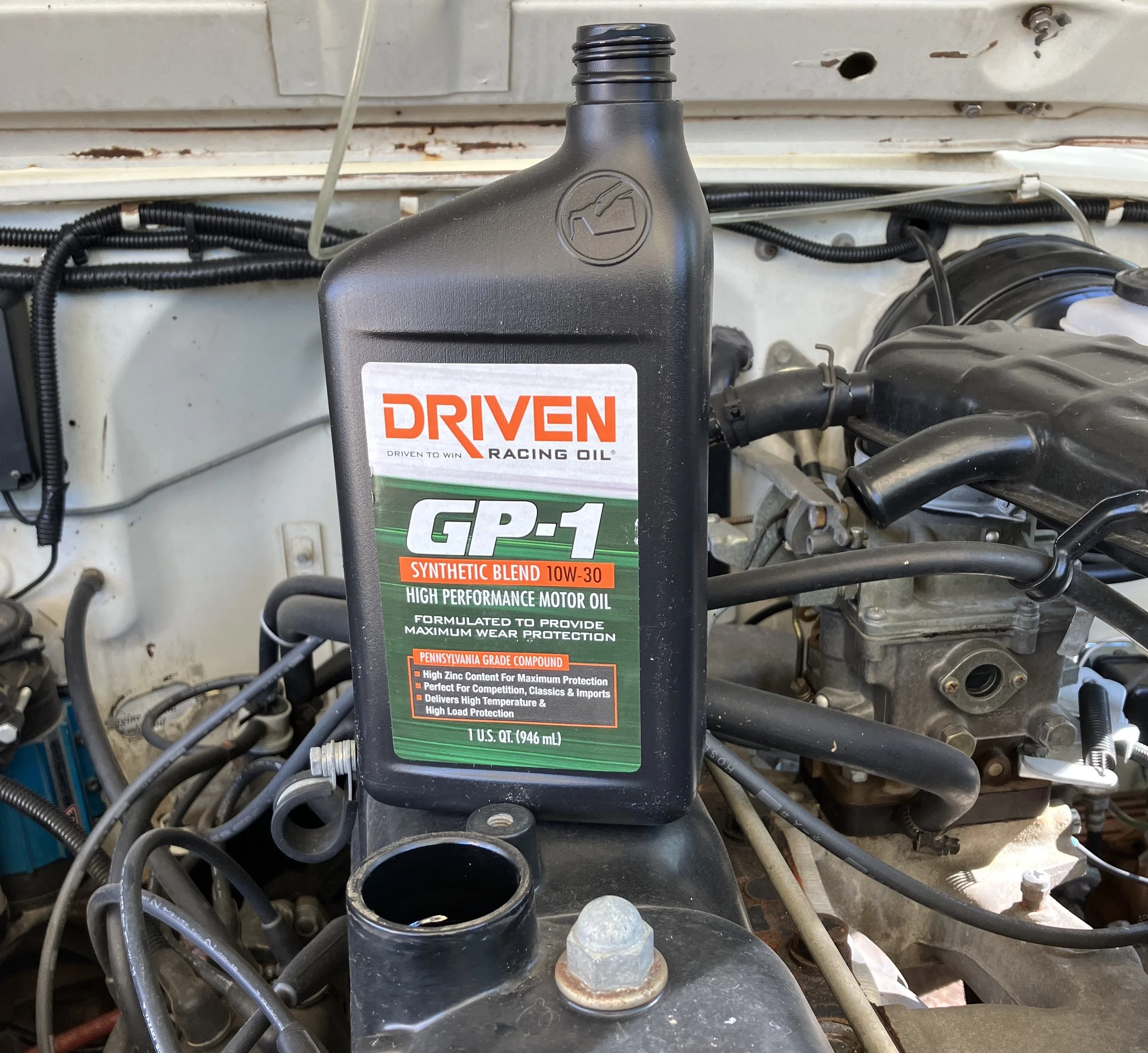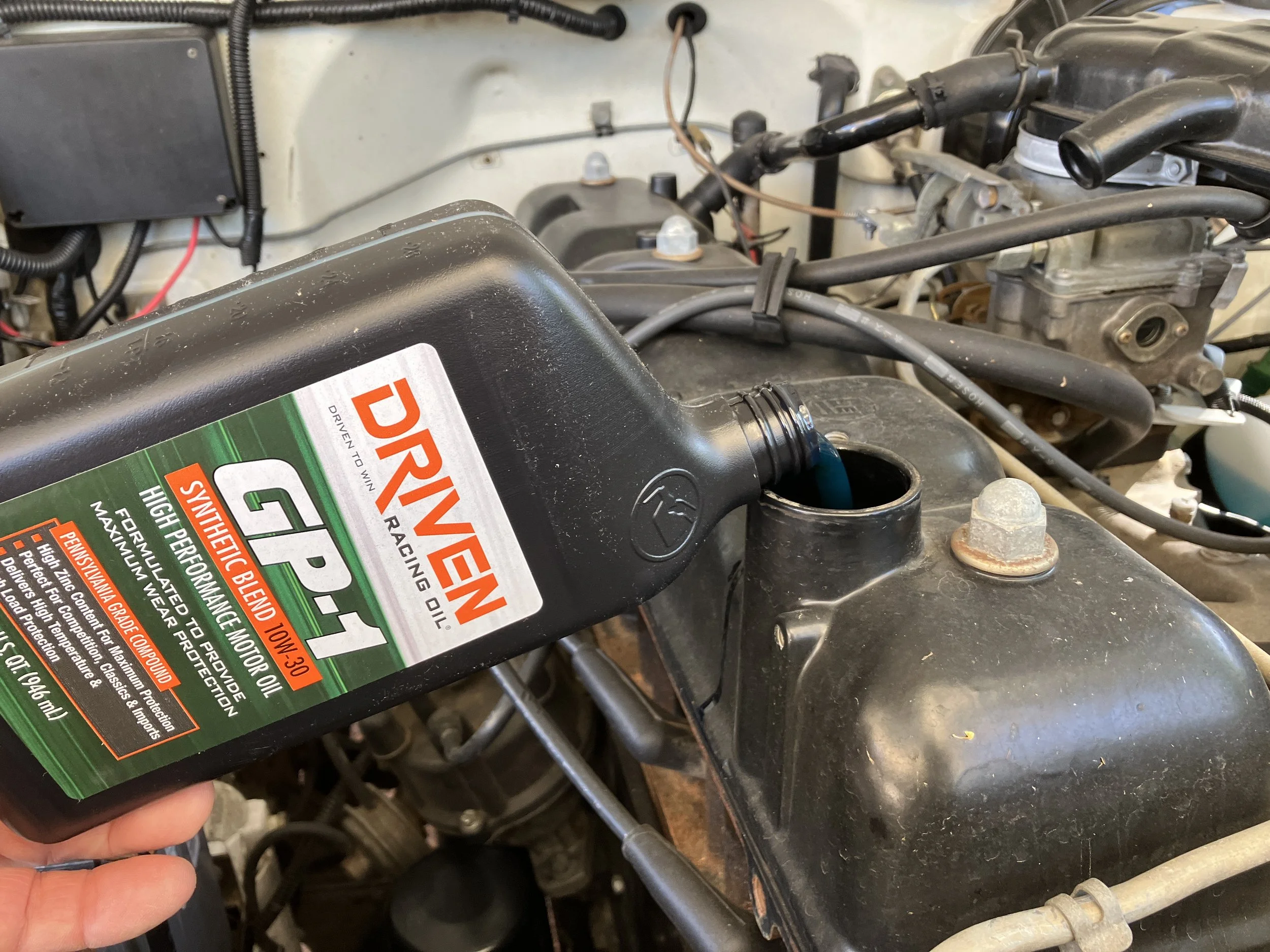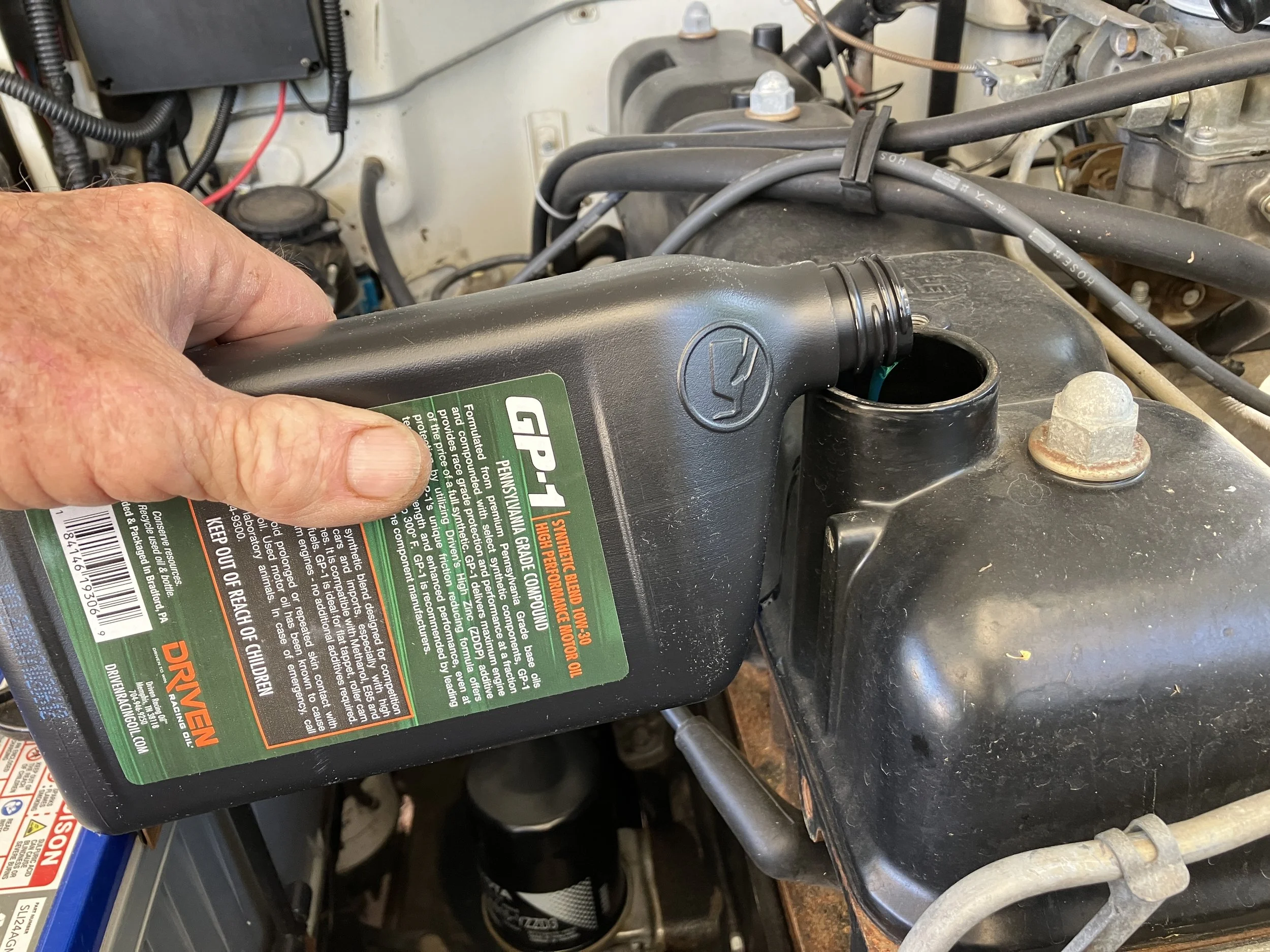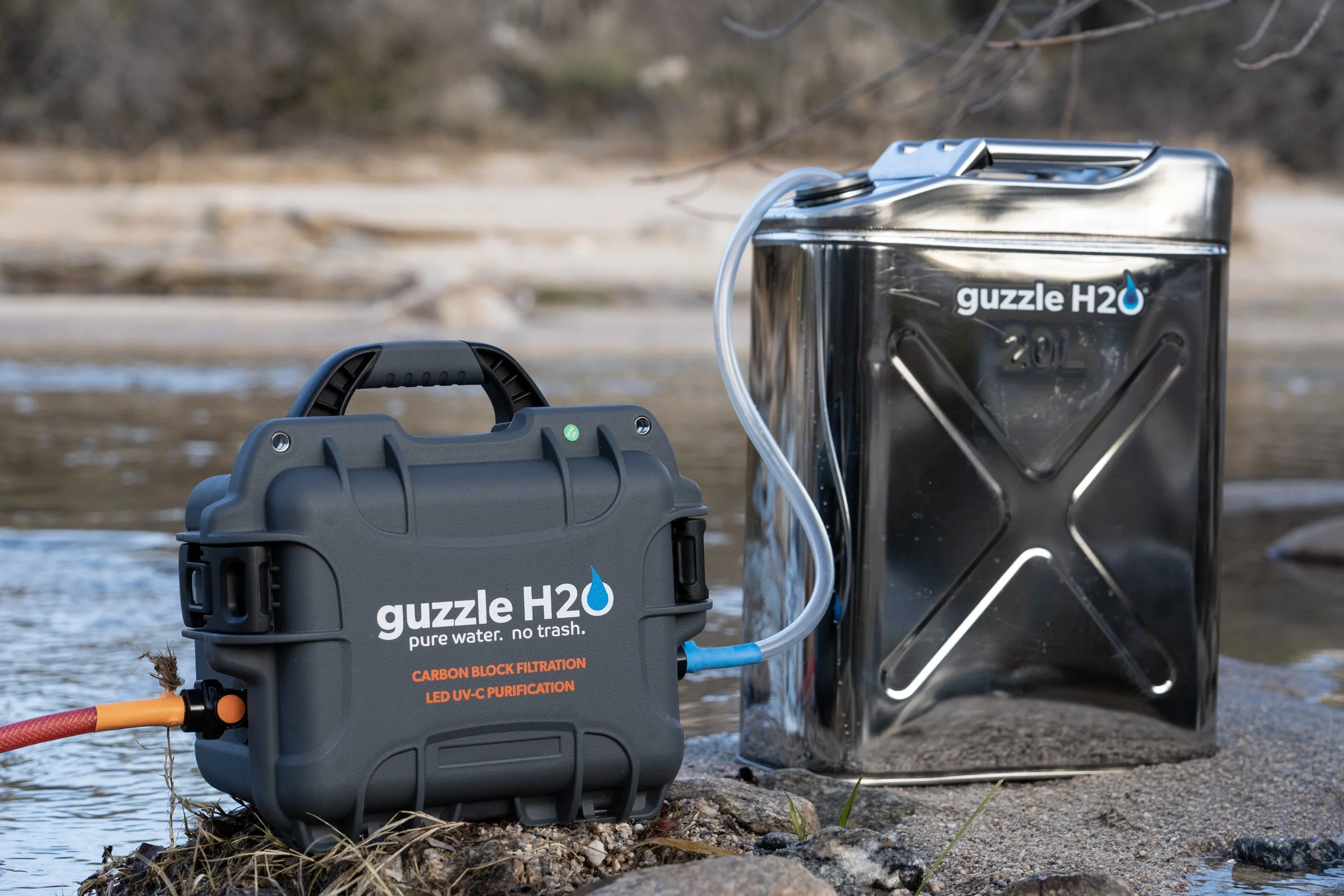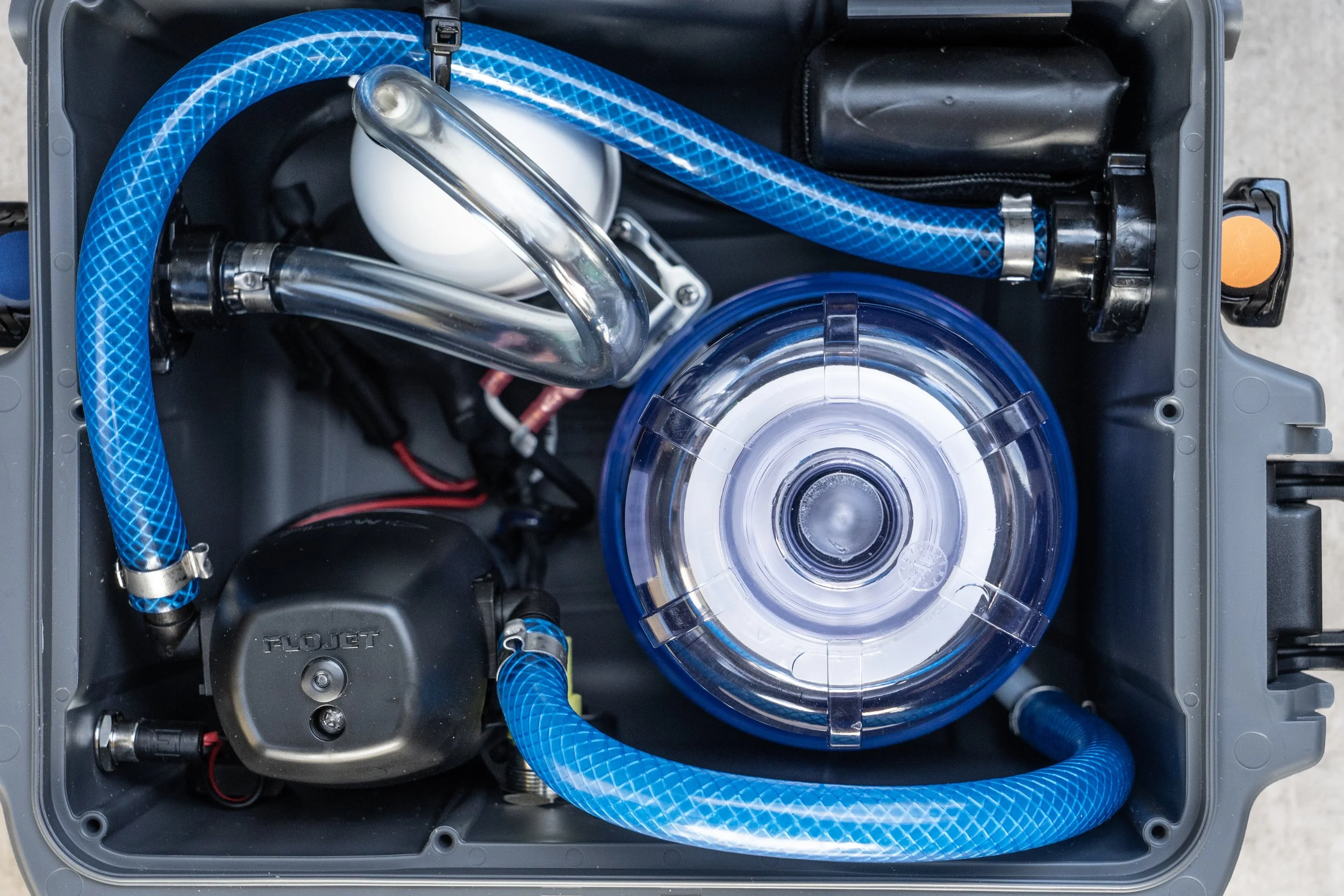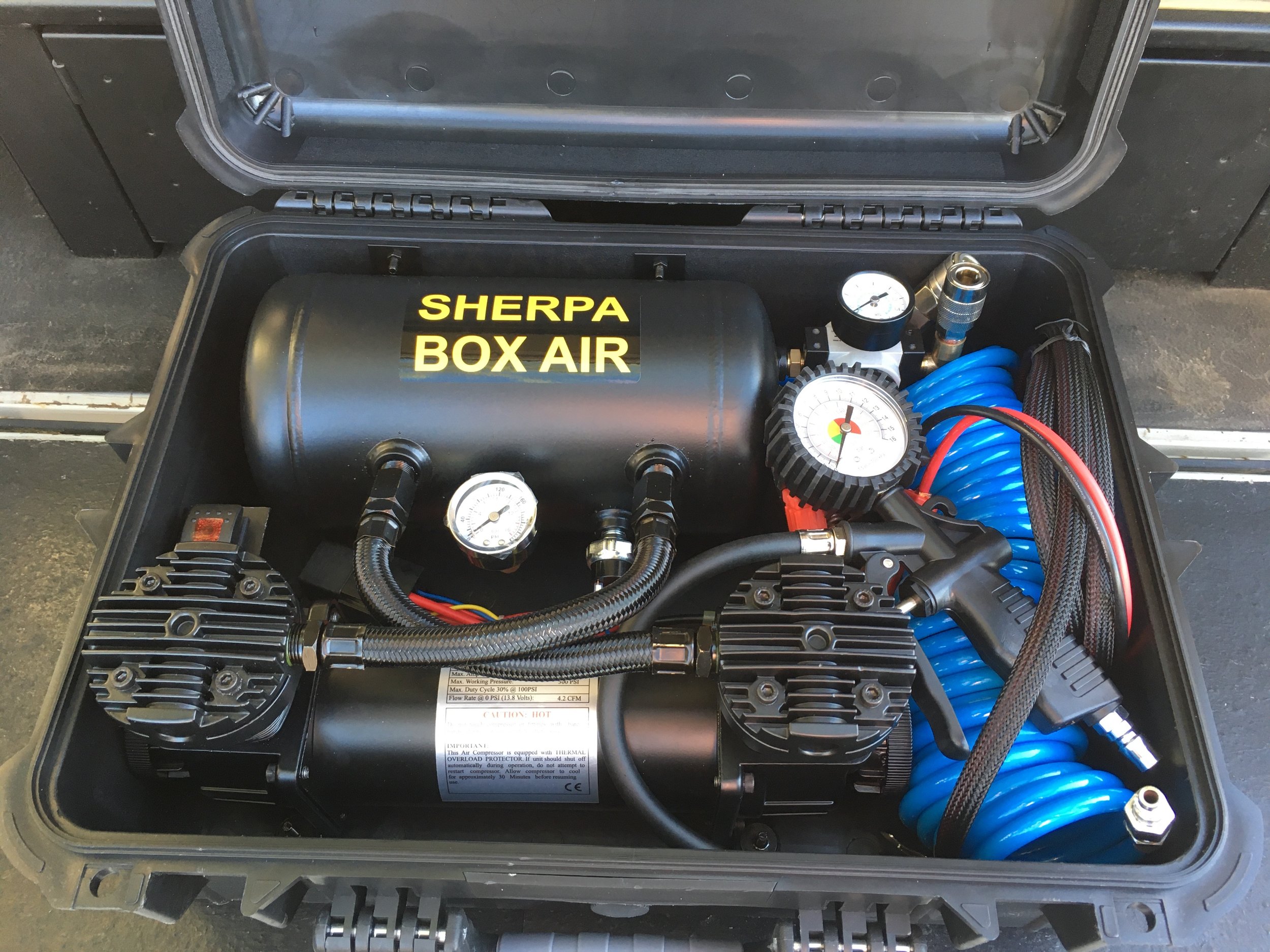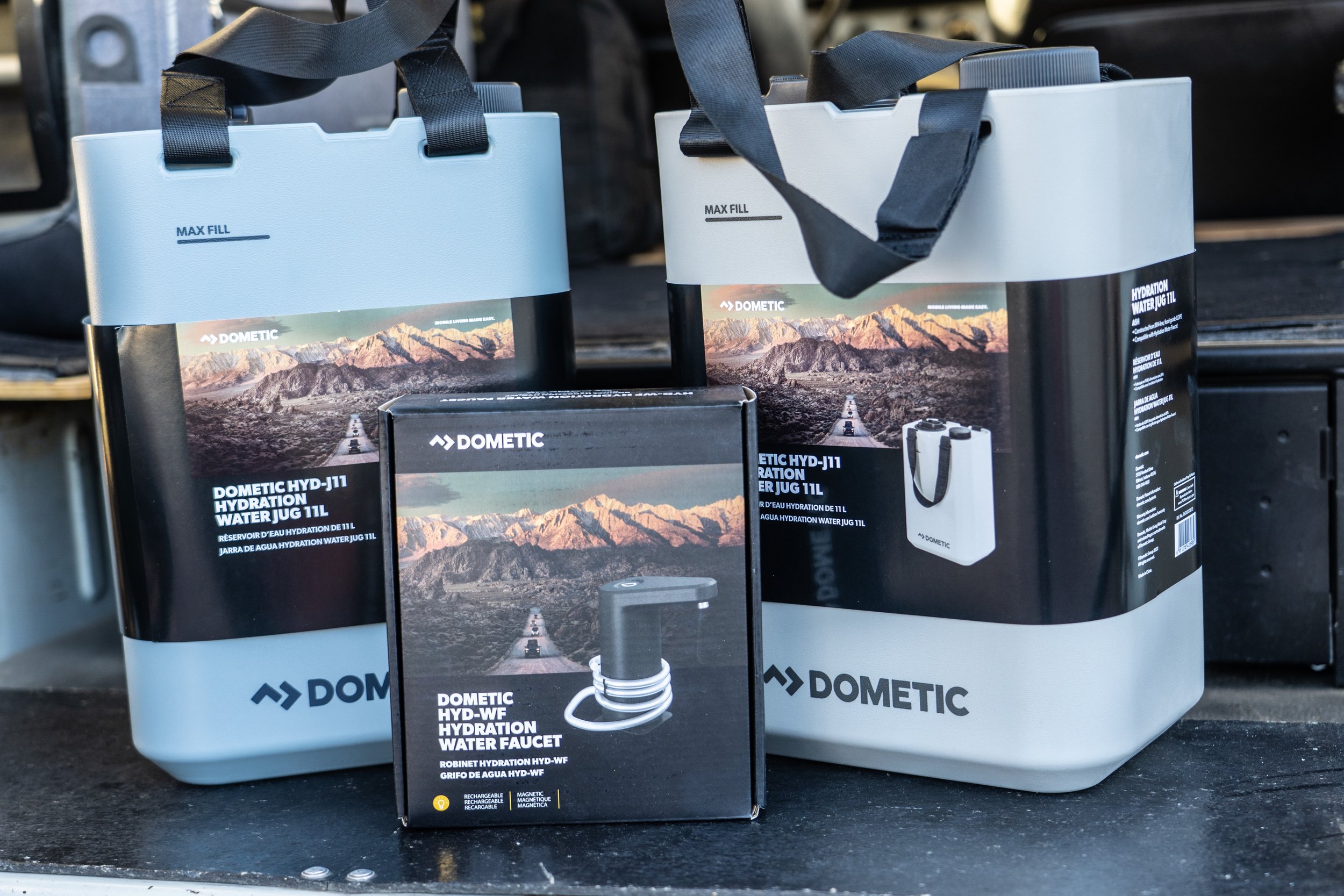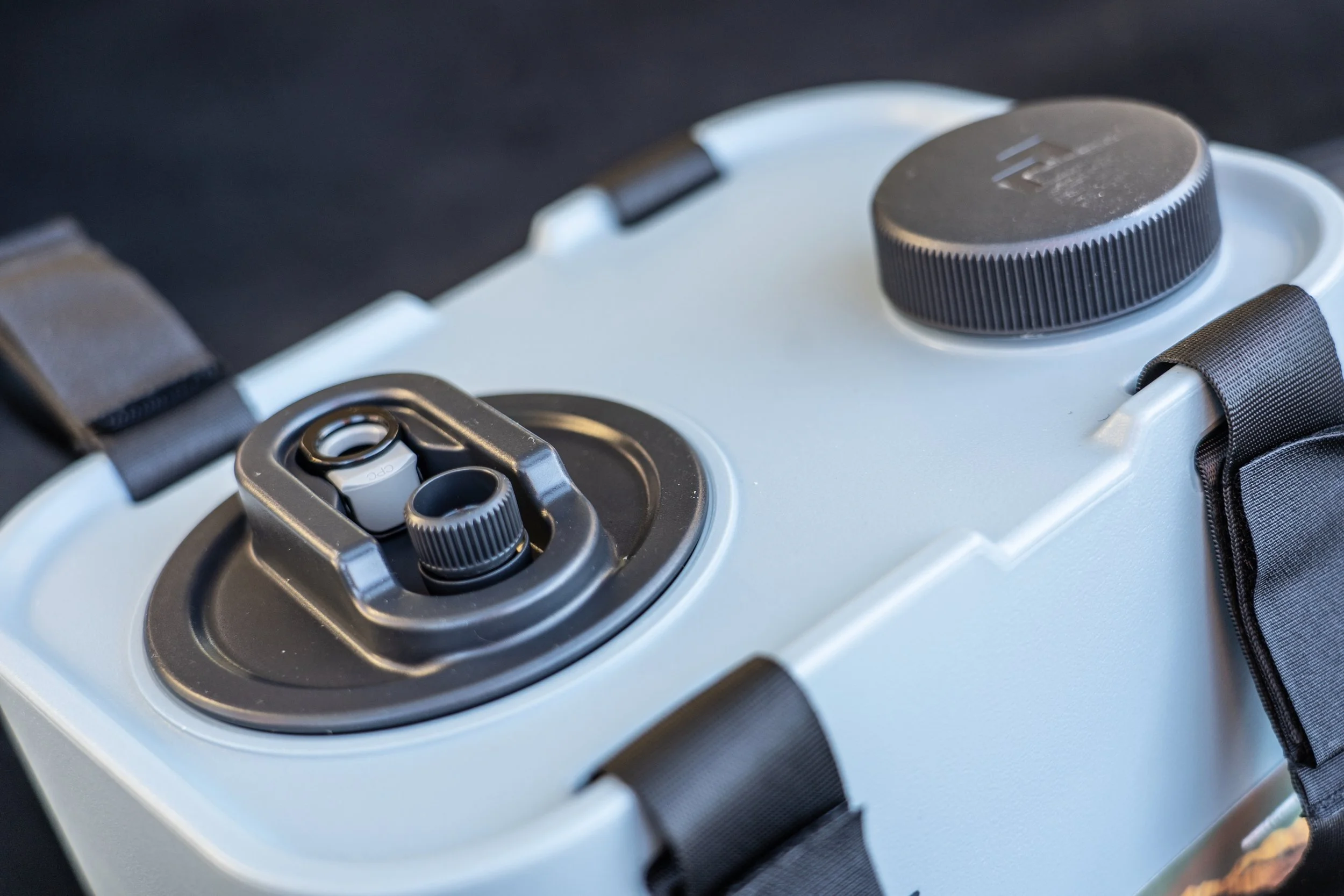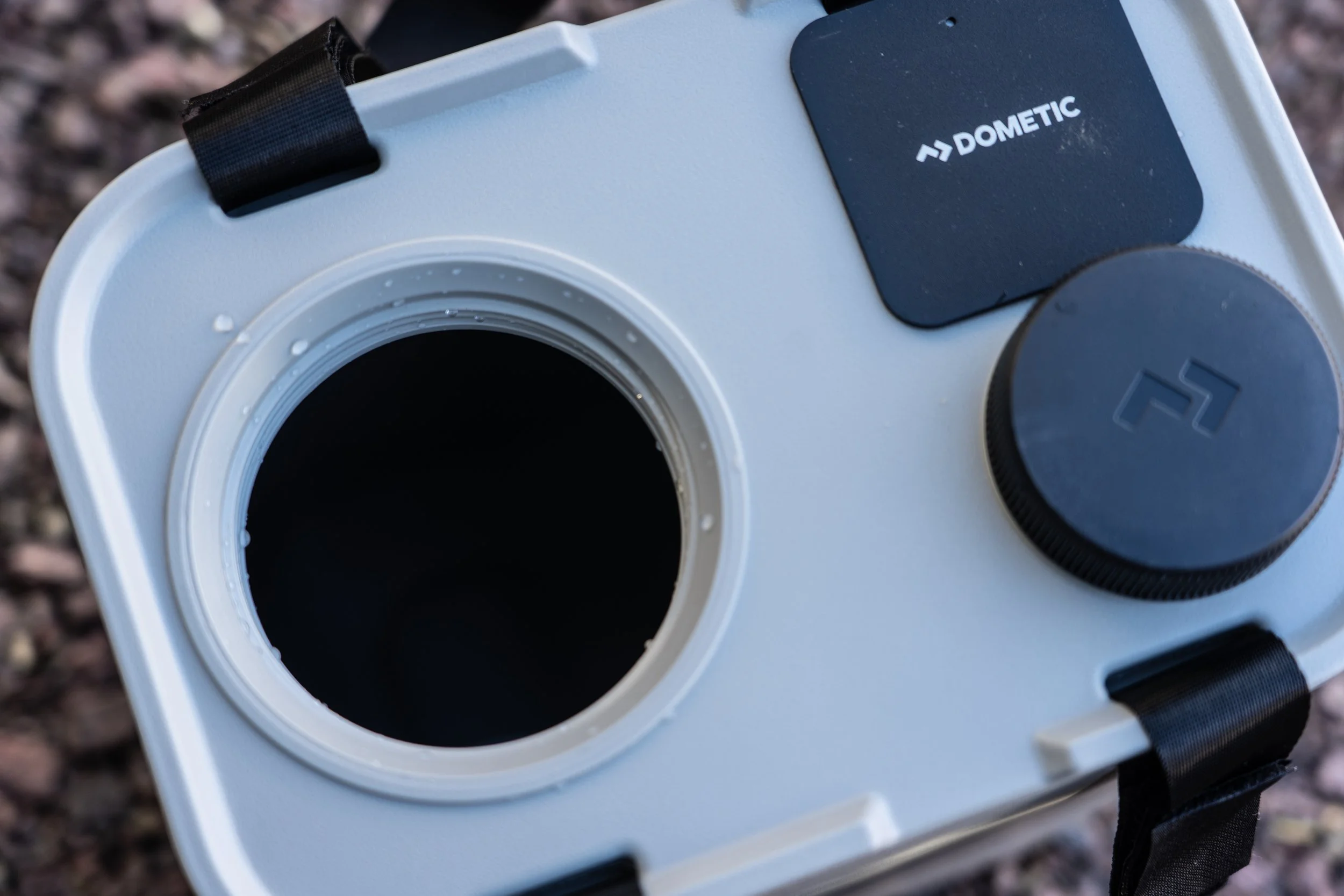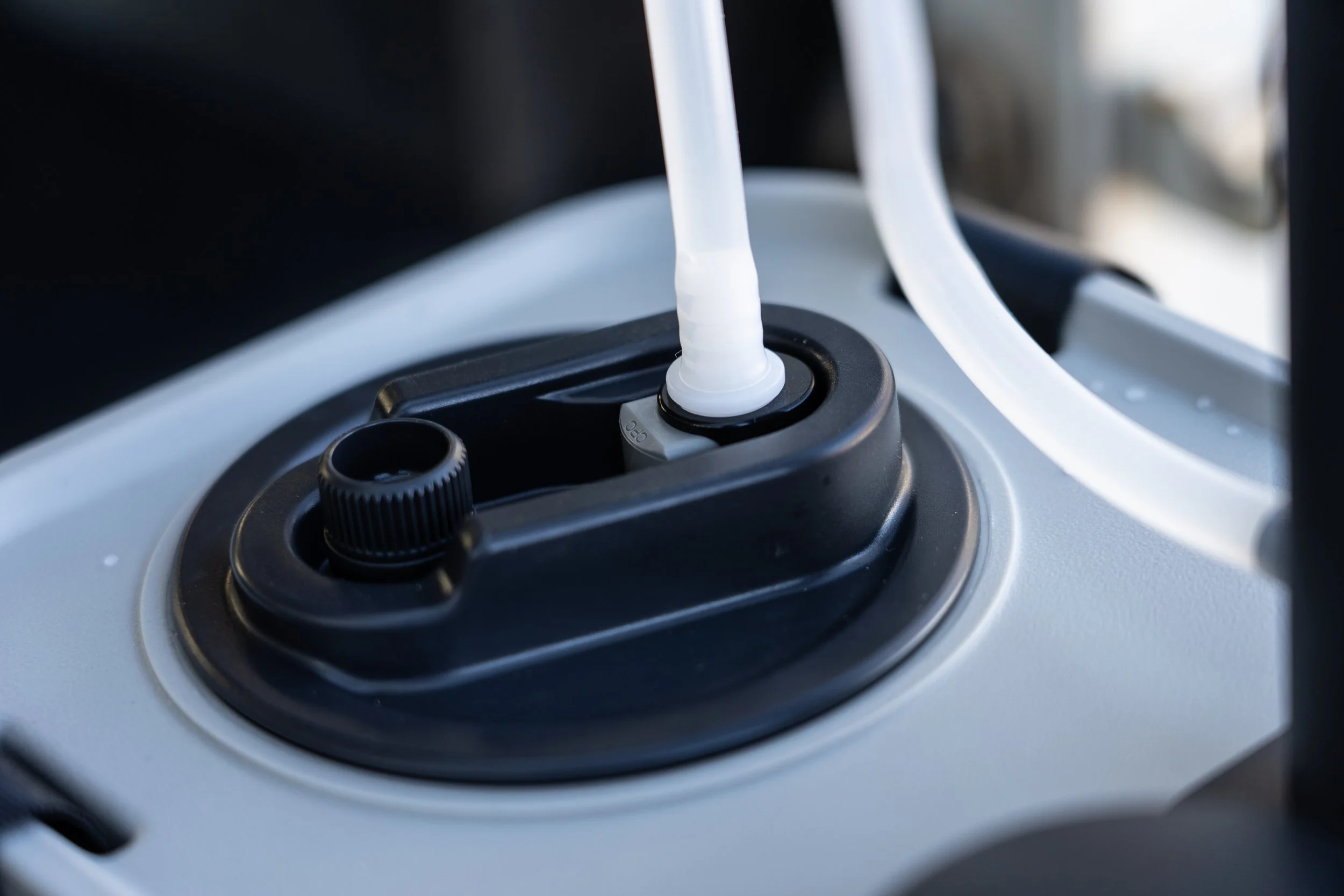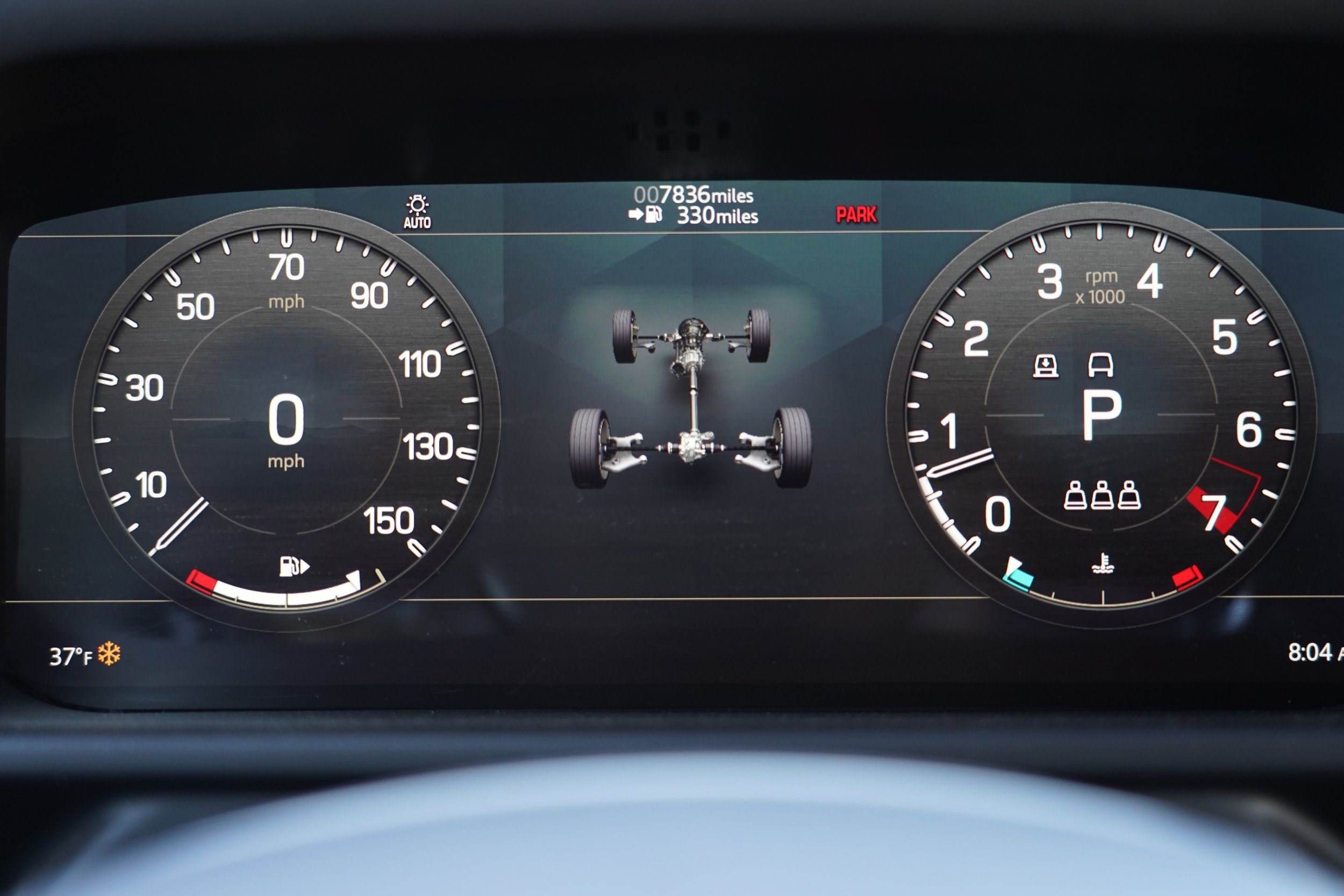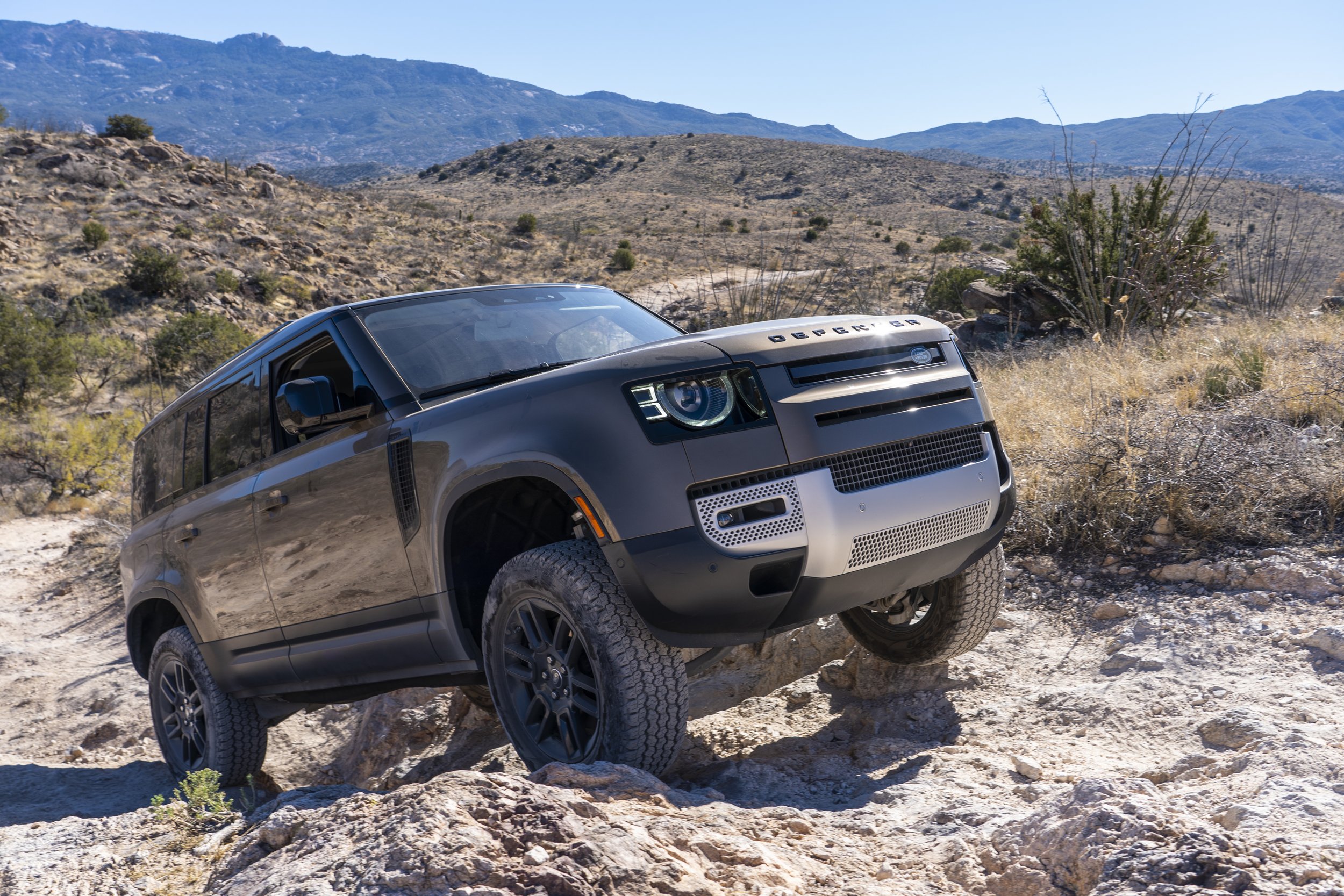
Overland Tech and Travel
Advice from the world's
most experienced overlanders
tests, reviews, opinion, and more
Pouring oil the correct way
Wait. Does anyone need instruction in how to pour oil into a crankcase?
Apparently I do, because it was only last year that I noticed a little icon near the top of a bottle of oil I was pouring into the Land Cruiser.
I had always poured it this way:
But the little icon told me to pour it this way:
And, well, to use the colloquialism . . . Duh. Poured this way the oil dispenses with zero gurgling, since air immediately enters the top of the bottle.
If I’m the only numpty on the planet, oh well. But if you read this and thought, “Ah ha!” Then you’re welcome.
The Guzzle H2O Stream: One purifier to rule them all?
All-in-one, fast purification. (The nifty stainless-steel jerry can is optional.)
Like it or not, the days are long gone when we could go a-wandering, knapsack on our back, and dip our Sierra Club cup into any lake or stream we came to. (And to be frank, the Sierra Club cup was a really lousy design anyway.)
Depending on which studies and statistics you believe, anywhere from 60 to 80 percent of the surface water—lakes and streams—in the U.S. is significantly contaminated with something not good for you, from E. coli to mercury. There are probably a few creeks at 12,000-feet-plus in the Rockies that are still as pure as God intended them, but everywhere else you’d be wise to ensure the water you use from natural sources has been purified, or at least filtered.
What’s the difference? In general, a filter is designed to remove such waterborne pathogens as protozoa (e.g., Giardia and Cryptosporidium) and bacteria (e.g., Salmonella and E. coli). A purifier will kill these organisms as well as viruses. Until recently, consumer-grade water filters could not block the passage of viruses, which average just .02 microns in diameter compared to the relatively huge size of bacteria (.2 to 1 micron) and protozoa (2 to 50 microns). The historically accepted methods for killing viruses included exposure to UV light, treatment with iodine, and boiling. Today several companies produce filters capable of blocking viruses, so the distinction has become somewhat blurred.
Do you need a purifier? At this time, for travel in North America, probably not, as viral contamination of surface water is relatively rare here (potential exceptions include, for example, lakeshores with heavy human activity). However, if your plans include exploration of developing-world countries, it’s definitely worth considering, as viral pathogens such as hepatitis A and E, norovirus, adenovirus, and enteroviruses, among others, might be present. And, after all, there’s no such thing as water that’s too pure.
There are dozens of filters on the market—including those capable of blocking viruses—suitable for backpackers and canoeists, who might need no more than a gallon or two per day. The MSR Guardian Purifier (the pump version) is one such. For overland travelers who have bulk water tanks in their vehicles, and who use that water for washing dishes and perhaps showering, and who thus might go through three, four, or more gallons per day per person, the work and time involved in hand-pumping a liter or two per minute would get old really fast.
One leisurely but effective solution is MSR’s Guardian Gravity purifier, which comprises a gravity-fed filter capable of eliminating viruses (NSF P248 standard), fed by a 10-liter hanging bag. The system produces only about a half-liter per minute (and it must be cleared of silt and debris in advance), but if you’re in camp for a few hours you can easily produce 20 or 30 liters of pure water. Of course you need to set a timer or keep an eye on the unit to know when to refill, and topping it up more frequently helps push water through the filter (slightly) more quickly. But otherwise it’s completely passive.
Want something faster than that? I’ve recently been using what might be the best high-output water-purification system I’ve ever tried.
The Stream from Guzzle H20 (Okay, I would have picked a different company name) comprises, in a compact Pelican-like case about ten by twelve by eight inches, a primary, easily replaced .5-micron carbon-block filter, a 12V pump powered by an LiFePO4 battery, and a transparent capsule incorporating an LED UV-C light source. The carbon-block filter removes chlorine taste and odor, and reduces or eliminates NSF 41 contaminants, VOCs (volatile organic compounds) lead, and mercury. The UV-C light inactivates protozoa, bacteria, and viruses with 99.99-percent efficiency, according to third-party testing. And the Stream produces an astounding .75 gallons per minute in pumping mode, or 1.1 gpm with a pressurized source such as a municipal tap. The LiFePO4 power source will process 32 gallons on a single charge in pumping mode.
What this means is that the Stream could completely refill our Land Cruiser Troop Carrier’s 29-gallon tankage (24-gallon chassis tank plus jerry can) with purified water on a single charge and in about 38 minutes—significantly less if sourced from a municipal tap. No other system I know of comes close.
Using the Stream couldn’t be simpler. The inlet hose plugs into a quick disconnect fitting on one side of the case; the outlet hose into a similar fitting on the other side. The inlet is color-coded red (in fact the entire hose is red); the outlet blue to avoid confusion. Stick the 1-micron pre-filter of the inlet hose into the source, hold the outlet hose over your container, and hit the switch. You’ll be surprised at the rate of flow—the thing fills a standard water glass in a few seconds.
I opted for the “Overland bundle,” which includes an extra carbon-block filter and a 30-foot outlet hose, so you don’t have to park right next to a source if you have built-in tanks in your vehicle. I also got the significantly larger “Guide” prefilter to clear up the murkiest swamp water.
With this setup I would have felt completely comfortable exploiting natural or municipal water sources anywhere I have traveled on any continent. I was impressed with the thought behind the system, the quality of the components and assembly, and the speed—and taste—of the output.
As you might imagine, the Stream is a significant investment. The standard model is $1,195; the Overland bundle is $1,288, and the Guide prefilter is $65. However, given that safe drinking water is arguably the number one concern on any trip, you might consider it a bargain. I do.
The most useful tool I've bought in a long time . . .
For decades I’ve used cheap plastic bolt checkers, with plain holes to confirm diameter and simple scales to measure thread pitch.
This is way, way better. It’s all-metal, and has actual bolt studs and threaded holes to instantly identify nearly any metric or SAE fastener. It took me seconds to identify a couple of weird bolt sizes (3/8 x 24, 1/4 x 28) on my 1976 Triumph TR6, which could theoretically have a mixture of SAE and metric fasteners.
It has holes at each corner, so if you wish you could mount it on the wall behind your workbench.
Made by Hillman. I found it at an Ace Hardware for $30, but you can probably get it or a similar model on Amazon. Highly recommended.
The Sherpa Box Air compressor system . . . initial review.
I consider myself the ARB Twin compressor’s number one fan. No other compressor I’ve used displays as much quality, versatility, and speed, either as a built-in unit—the configuration we have on our Land Cruiser Troop Carrier—or as the cased portable we also own, with its included air tank.
However. No one, including me, ever called the Twin a screaming bargain, at $600 for the stand-alone compressor or an eye-watering $990 for the portable unit. If you can afford it, it’s worth every penny. But what if that’s simply too much for your budget?
Recently I found what might be a legitimate alternative in the Sherpa Box Air system. At a glance it seems to be a close copy of the ARB Twin Portable, incorporating a twin-cylinder compressor with an air tank inside a Pelican-style case. The price of the Sherpa Box Air, however, is $629 including free shipping from Australia. (Astonishingly, the unit I ordered arrived on my doorstep just four days later, thanks to DHL.) The Sherpa also includes a trigger-style air chuck with a built-in pressure gauge, which the ARB does not.
That sounds like an open-and-shut case, so to speak. However, there are a couple of significant differences between the two units. The ARB Twin is fan-cooled, which in addition to its high-quality internals lends it a superb 100-percent duty cycle. The Sherpa, by contrast, is not fan-cooled and has a 33-percent duty cycle. Otherwise, factory specs regarding air flow and amperage draw are remarkably similar.
On balance I strongly prefer a 100-percent duty cycle; however, a 33-percent duty cycle is not necessarily a deal breaker as long as the unit can air up a full set of tires—or yours plus a friend’s, say—before needing a rest.
I plan to do a side-by-side comparison soon. In the meantime, Sherpa is here.
Edit: I just discovered that Sherpa has updated the Box Air with a slimmer twin compressor that is fan cooled and more closely resembles the ARB design. See below. The duty cycle remains at 33 percent, however.
Seemed like a good idea . . .
Mount a massive (5,000 pound dry weight) overhead camper with an eleven-foot-long floor and multiple slide-outs on a short-bed truck. Then hang a motorcycle off the back.
The owners claim Ram should be responsible for the very expensive repair, saying the stated load capacity of the 3500 truck is 7,680 pounds. It appears, first, that they specced the wrong truck, looking up a regular-cab, long-bed 2wd 3500 model. The capacity of a crewcab 4x4 is significantly lower.
But that’s nearly beside the point. It doesn’t take much thinking to realize that a pickup is designed to carry its stated load in the bed, not six feet off the back. The leverage applied to this truck’s chassis must have been stunning over mediocre Baja roads. I’m on the side of the giant corporation this time.
Full story on MSN here.
Dometic's brilliant GO Hydration Jug
Despite being lucky enough to have reviewed hundreds—possibly thousands—of products over the last 35 years, from utensils to Unimogs, I’m not the least bit jaded. I still love doing it, and I still get excited whenever a box shows up at our mail depot with some new bit of kit to try.
I am, however, harder to impress than I used to be. And I’ve noticed that certain types of product—lightweight stoves, backpacking tents, binoculars, 12V fridges, and camp seating come immediately to mind—tend to go a long time between genuine innovations.
Until recently that was the case with portable water containers. You had your blue steel NATO can—my longtime standby—the Scepter, the Reliance, and a host of generic plastic five-gallon/20-liter clones. The Lifesaver can stood out for its purification function, but otherwise it was pretty much a standard H2O jerry can. The Rotopax was innovative in terms of its shape and mounting hardware, but (very) expensive as a system, and again more or less just a container. (It’s also, through no fault of the company, become something of a caricature as a de rigueur external accessory to announce that you are driving an OVERLANDING VEHICLE.)
Then, at this spring’s Overland Expo West, I was introduced to Dometic’s new GO Hydration Water Jug. Two minutes into the rep’s spiel, I knew it was different. Revolutionary might be too strong a word, but it’s got genuinely clever innovation in every feature. After the show, for the first time in a long time, I actually pestered my contact at Dometic to get a review sample. It took a while because it seemed others had been impressed too: the units frequently sell out.
Why was I so impressed? Let’s look at the product and the thinking behind it.
First, the designers realized that a full five-gallon jerry can of water, which weighs 45 pounds give or take depending on the container, is an awkward thing to carry, not so much due to the weight as the awkwardness of having the weight all on one side. So they essentially cut the dimensions of a jerry can in half. Turn a Dometic jug on its narrow side and stack another on top of it. The two take up just about the same space as a single standard jerry can, and in fact will fit in many jerry can holders. Yet each jug holds 11 liters, 22 for a pair. That’s 5.8 gallons, more even than a NATO can. Despite that, two full Dometic jugs, one on each side, are far easier to carry than a single jerry can with less capacity. One-and-a-quarter inch (removable) webbing straps help with comfort.
Upright, the jug is stable, and two grooves in the top rim facilitate securely strapping it down (or you can use the carrying straps).
There are two openings in the top. The smaller one is, cleverly, a standard 63mm Nalgene size and thread, which means you can screw any one of a number of water filters directly onto it to fill the can with filtered/purified water. Remove the cap and you’ll see a rubber flow control plug, which allows you to tip and fill small containers without spillover. A groove in the bottom of the can provides a secure grip for your bottom hand. Remove the flow control to quickly empty or fill the jug. In addition to the cap, the Dometic jug comes with a twist-valve replacement cap, to allow simple gravity feed with the can on its side.
The other, larger cap, unscrews to reveal an opening large enough to insert your hand and forearm for scrubbing when necessary—something few if any other water containers allow. It’s big enough to allow filling the can from a bucket with little if any spillage. The cap itself incorporates a screw-down breather, to avoid vacuum lock when dispensing from the tap or pump, and a CPC quick-connect fitting that is connected to a silicone feed tube which reaches the bottom of the can.
The fitting is used with the Dometic can’s nifty option: a USB rechargeable pump that dispenses water with a double tap on a touch-sensitive switch, and automatically shuts off after one liter or one minute, in case you set it to fill a pot and wander off and forget because you’ve just noticed the black bear rummaging through your Dometic fridge. The pump has a magnetic base, and comes with two plates which you can affix with adhesive pads to the can itself or anywhere else. The pump will also obviously stick to a steel bumper, tailgate, or the edge of a truck bed. (Land Rover and newer Ford pickup owners will need to use the stick-on plates.) An LED lights up the spigot area in the dark. Nice.
The Dometic Hydration Jug is made of food-grade (did they need to tell us that?) LDPE, and these things are stout. I stood on top of one that was erect, then I stood on it laying on its side. It didn’t squeak. Yeah, I’m probably lighter than the average American these days at 150 pounds or so, but you get the picture.
See why I was impressed? And in use, every feature functions just as it’s supposed to. The rechargeable pump is neat, but you don’t really need it; the included twist valve and gravity feed works just fine, especially given the breather.
A single Dometic Hydration Jug would be worth having even if you already have bulk water storage in your vehicle. Having a portable 11 liters of water with either a spout or a lighted pump would be handy in many situations—carry it to a picnic table if you’re transiting and staying at Jellystone Park. In fact, with the pump you could easily rig one of these as an impromptu shower.
Dometic has released a flurry of well-designed new products in the last year. The GO Hydration Jug is one of the best. Highly recommended.
Find Dometic here.
Trail Turn Assist, the Rivian "Tank Turn," and other environmentally destructive tricks.
During my test of the new Ford Bronco—a vehicle I liked a lot—I tried out its Trail Turn Assist feature, as you can see demonstrated in the video above. TTA drastically shortens the turning circle of the vehicle by applying the brake to an inside wheel, essentially dragging it through the turn.
Of course, in a normal scenario you wouldn’t be initiating a 360-degree turn such as in my demonstration above, conducted in a heavily used wash and cleaned up afterwards. Its utility would be negotiating a tight maneuver when, say, a boulder threatens the outside corner of the vehicle, or a drop-off threatens the entire vehicle. However, there’s nothing to prevent an owner engaging it simply to show off how tightly he can reverse course. And no matter how briefly one engages it, it will impact the trail.
My approach to driving, or to teaching someone to drive—as with all instructors I know—is, at all times, to try to minimize or eliminate wheel spin, which causes both a loss of traction and control and results in degradation of the surface, particularly in places where multiple vehicles are likely to lose traction. And wheel spin while the vehicle is stationary does more or less precisely the same thing as a locked wheel while the vehicle is moving: It wears away at the substrate, increasing erosion.
I’m not going to claim I would never use TTA if I owned a Bronco, but I would be extremely reluctant to do so.
As potentially damaging as TTA is, it pales before the much-hyped “Tank Turn” the much-hyped Rivian electric pickup can accomplish. By powering both wheels on one side forward and both wheels on the opposite side backward, The Rivian can essentially spin in place. The resulting destruction of the trail is easy to see in the videos produced by the company itself. You can see the entire sequence here.
The Tank Turn “feature” has actually been delayed for an unknown period after the Rivian engineers recognized several issues—including the fact that when the turn is enabled, traction is completely lost. Thus if an owner were to initiate it on a slope, the vehicle would immediately begin sliding downhill.
Rivian will undoubtedly warn that the feature is only to be used on a “closed course,” just as they say for their “Drift Mode,” designed for “advanced drivers wanting to drift their R1T on a closed course.”
Wink, wink.
Sadly such hypocrisy is by no means limited to the Rivian company (see here). Every truck maker loudly proclaims adherence to Tread Lightly practices, while producing advertising material expressly promoting the exact opposite. There are certainly those consumers who are responsible enough to eschew aping the ads, but there are tens—hundreds—of thousands who are not. I see the results every single time I head out on a trail, and it has been getting exponentially worse. Blame it on what you will, but there has been an unmistakable increase in self-centered behavior on public land in the last half decade or so. More litter, more driving completely off trail, more hooning on the trail. These are not the type of people who will respond to a friendly lecture. Yet they are the ones who will scream when severely damaged trails are shut down by overworked and underfunded public lands managers.
Short of funding a sniper division in the BLM, I really don’t have a solution.
This is not your father's Land Rover Defender
(Note: A version of this article originally appeared in Wheels Afield, Spring 2021. I’ve expanded it here, and also included some comparisons to two vehicles potential buyers might also consider, the Wrangler Rubicon and the new Ford Bronco, a Badlands version of which I recently tested. Keep firmly in mind that the Defender costs around $15,000 to $20,000 more than the other two with similar spec, due in large part to its technologically more complex, aluminum-intensive unibody construction and all-independent air suspension.)
A line from my test notes reads: If you need a quick 90-mph sprint to scoot past a paint-scouring dust devil charging the highway ahead of you, the new Land Rover Defender is eager to oblige.
I’m willing to bet that’s the first time you’ve read “quick 90-mph sprint” and “Land Rover Defender” in the same sentence.
I also could have included in that sentence terms such as unibody construction, fully-independent air suspension, 14-way memory heated seats, photo-darkening windscreen, panoramic sunroof, 400-watt Meridian sound system, dual-zone climate control . . . but you get the picture. Stepping from the last iteration of the Land Rover Defender into the new one is like going straight from an Underwood typewriter to a MacBook Pro.
As a fan (and owner) of the original Defender, I was one of approximately eight aficionados worldwide who weren’t enraged at the re-invention of the world’s most famous safari vehicle. I knew it was never going to be another bolted-together oxcart an owner could rebuild—and might well have to—under a mango tree in Zambia. It couldn’t be. Times have changed, and so has Land Rover. The company tacitly ceded the expedition, NGO, and insurgent market to Toyota’s bulletproof 70-series Land Cruiser a couple of decades ago.
At the same time, they were never going to retire the name Defender like some star ball player’s jersey number—it is marketing platinum. Thus the new Defender.
And what to make of it? In the glacially extended run-up to its actual introduction, JLR (Jaguar-Land Rover) claimed the new Defender would eclipse its predecessor in comfort, handling, safety, economy, and power, while also surpassing it in off-road ability—no great feat on the first bits, but challenging indeed to simultaneously achieve the latter. In early January 2021 I finally got a 2020 Defender 110 SE all to myself for four days to prove or disprove those claims (press launches are interesting, but minutely orchestrated to show off all the strengths of a product and none of its flaws).
The first official photos of the new Defender elicited a collective “Eew!” from traditionalists. Despite JLR’s references to numerous “stirring evocations” of the original two-box design, modern aerodynamics and aesthetics have melted the shape into a generic form more likely to be mistaken for a Kia Soul than a Series II. By comparison, any Jeep or Bronco owner brought to 2021 from 1966 would instantly recognize either vehicle.
The rounded edges also have the effect of making the new four-door Defender 110 look decidedly smaller than the old one, despite the fact that it is larger in every dimension except height (and even that with the air suspension fully raised). It’s also heavier.
I got used to the unexceptional styling. I did not get used to the “Martha Stewart sample swatch,” as I called it: the strange body-color square stuck in the middle of the greenhouse. I could picture a couple agonizing over the paint choice on their new Defender. “Okay, how about this one? It’s called, um, Gondwana Stone?” (Don’t laugh—that is the actual name for the color on my test vehicle.) Some gloss black Krylon would fix the sample swatch. At least my ride didn’t sport the bizarre, optional Flintstones-lunchbox “side-mounted gear carriers,” which perform the dual function of hampering rearward vision and compromising aerodynamics.
Any sense of disappointment disappears once you slide into the driver’s seat. The new Defender has what is quite simply the most strikingly elegant dash ever put into a production vehicle. The instrument cluster in front of the driver employs all-LED instrumentation, including the “analogue” tach and speedometer—brilliantly crisp and visible in any conditions, and of course programable to display various functions and gauges. The 10-inch touch-screen in the center of the dash, nestled below an upholstered but structural magnesium beam/grab bar spanning the width of the cockpit, actually looks like it belongs there, in contrast to the stuck-on-iPad look of so many; its graphics are sharp, and function, according to my tech-savvy wife, is intuitive. A pod below houses the stubby shift lever and twin climate control/multi-function knobs. There are a few ergonomic glitches—the gear indicator on the shifter is invisible when you’re actually shifting (although there’s a duplicate next to the tach), the low-range button is oddly tiny in comparison to its importance, and identifying the button to convert one of the climate-control dials to a 4x4 drive-mode selector requires a dive into the 490-page owner’s manual. Quibbles, really—I could sit and admire this dash for hours.
By comparison, the current Wrangler dash is pleasingly robust-looking, and major dials are easily read, but it is far less elegant. The new Ford Bronco’s dash pales in comparison; it’s an awkward mix of round and square dials, although the Bronco’s traction-aid buttons are all in a row in the top center of the dash—a brilliant arrangement and more logical than the Defender’s more cryptic placement.
In back there’s comfortable seating and, more important, a completely flat, rubber-matted load bay with the rear seats folded, perfectly rectangular. Owners under five-ten or so will find it comfortable to sleep side by side as a couple, or solo (diagonally) if you’re taller.
Going back to the Wrangler and Bronco: The former suffers from speakers and other structures that intrude into the load space, especially at the back. The latter has a very usable rectangular load bay, but there is a sharp raised shelf where the back seats lie down. The Defender’s load bay wins easily on space—and load carrying as well: Thanks partly to those adjustable air springs, the Defender will carry 600 pounds more than the Wrangler Rubicon, and almost 800 more than the Bronco.
With the power seat adjusted every way to Sunday, and the tilt/telescope wheel positioned, the promised massive improvement in comfort becomes plain. “Land Rover elbow” is officially an affliction of the past. Push-button-start the 395bhp/407lb.ft. Ingenium 3.0-liter inline six, both electrically supercharged and twin-scroll turbocharged, and backed by ZF’s excellent eight-speed transmission, and it’s also clear no Defender owner will ever again be beaten from a stoplight by a furniture-delivery truck. Zero to 60 in 6.5 seconds puts it level with my old 1982 Porsche 911SC. Yet on a 300-mile mixed highway/dirt road trip we managed a bit over 21mpg on the suggested premium fuel. (Base models come with a four-cylinder 2.0-liter with a mere 300 horsepower.) It’s faster than a Bronco with the 330hp 2.7-liter V6, and way faster than a Wrangler with the 285hp 3.6-liter V6. The Defender also delivers its torque much lower in the rpm band than either, which is better for towing and trail performance.
That highway experience would have been sheer fantasy to any early Defender owner. In “Comfort” mode the all-independent, air-sprung suspension lends the ride of a—dare I say it?—Range Rover, with interior noise levels nearly as quiet. At an 80-mph cruise normal conversation is, well, normal. Passing semis in a vicious side wind elicited not a twitch in the steering wheel. Short of JLR’s own premium models it was the most comfortable on-road experience I’ve ever had in a four-wheel-drive vehicle.
The Wrangler, by comparison, exhibits a much firmer ride, looser steering, and obviously more transmitted road noise. The Bronco I reviewed, riding on the 35-inch Goodyear tires of the Sasquatch Package, also rode much more firmly, and displayed enough tire noise at freeway speeds to make conversation difficult—a disappointing revelation.
So: Full marks to Land Rover on transforming the Defender’s comfort, handling, safety, economy, and power. What about off-road performance?
The Defender is built on a new, aluminum-intensive platform called D7x. Engineered to pass something called, alarmingly, the Extreme Event Test (part of which involves driving repeatedly into a six-inch curb at high speed), it also raises the body of the Defender slightly higher that that of Land Rover’s other models. With the air suspension at its tallest setting, ground clearance below the nearly flat underbody is a full 11.5 inches. Approach and departure angles of the 110 are excellent at 38 and 40 degrees. (I much prefer a departure angle greater than the approach angle—if the front end clears you know the back will.) Breakover angle is also good at 28 degrees. These specs all compare favorably with the corresponding Wrangler (43º/37º/26º) and Bronco (44º/37º/23º), especially in departure angle, and the Defender’s wading depth of 35 inches beats them both (Wrangler, 30”, Bronco 33.5”). Additionally, put the Defender’s Terrain Response selector in Wade Mode and it raises the suspension to its maximum, locks the driveline, displays the water depth on the center screen, and, last but not least, lightly drags the brakes to dry them once you emerge. Impressive.
I dialed in another Terrain Response mode—Rock Crawl—for a day in Redington Pass east of Tucson, along the same route I’d earlier taken a Jeep Gladiator Rubicon diesel. With a 119-inch wheelbase instead of the Gladiator’s 137, the Defender didn’t kiss a single rock, and otherwise went everywhere the Gladiator had gone with its dual lockers and disconnected front anti-roll bar. (I did wish the Defender had the Jeep’s 17-inch wheels rather than the supplied 19-inchers, which reduce sidewall height and don’t allow airing down as much.) Rock Crawl mode locks the center and rear diffs; however, the front is left to make do with brake-actuated traction control, so those tires scrabbled a bit on steep climbs before grabbing. Nevertheless it was clear that the new Defender decisively eclipses the old one in this sort of terrain. The original’s admirable coil-spring compliance simply wouldn’t be able to overcome the lack of any cross-axle locking function. I should note that fuel economy dropped precipitously near to single digits for this run—not unexpected but roughly half what a Gladiator’s turbodiesel managed in the same circumstances.
The Defender has other tricks: ClearSight Ground View, which magically makes the hood disappear in dicey terrain, additional camera modes that lend close-up views of the front wheels or a bird’s-eye perspective. All-Terrain Progress Control allows the driver to dial in a walking pace and concentrate on steering rather than throttle management. And all the while the suspension and silky transmission continued to coddle us. At the end of the day Roseann and I agreed that neither of us had ever experienced a vehicle so comfortable on pavement and at the same time so capable in the backcountry.
However, I’ll state that here the Defender’s 4WD proficiency lags slightly behind its American rivals, largely due to the lack of a front locker and its 19-inch wheels. The Wrangler Rubicon reigns supreme in rough country, with the Bronco perhaps a tick behind. I’d rate the Defender at 90 percent of either of them. One could enhance this by installing the 18-inch wheels that are optional, along with slightly taller tires—but I would be very cautious not to compromise the overall brilliance of the Defender’s capabilities on and off road.
Another factor to consider for some of us is the difficulty of fitting (or finding) aftermarket accessories. Land Rover offers a winch as a factory option, but fitting one later might be nearly impossible for the near future. The last I heard, none of the major players in the 4x4 accessory market (ARB, etc.) is producing a winch bumper or recovery-capable rear bumper.
Of course the 800-pound gorilla lurking in the cargo compartment of the new Defender is the question of reliability. The legendary original was not, shall we say, legendary for this, and the new one is orders of magnitude more complex (quite literally a Macbook Pro versus an Underwood). Time will tell if the new, dedicated plant in Slovakia can exceed the quality of the venerable works in Solihull. One early YouTube saga involving a complete engine failure made a splash for some time, and others have surfaced detailing lesser issues. Only time will give us statistically valuable data.
In a way the baggage of that legendary name is unfortunate. If JLR had named this vehicle anything but Defender, it would have been greeted rapturously by Land Rover fanatics. The rest of us can greet it for what it is: a supremely accomplished 4x4 that is also comfortable for 600-mile freeway days, and capable of carrying nearly a ton of passengers and camping gear, or pulling four tons of trailer. I wouldn’t recommend trying to disassemble it under a mango tree with a hammer and a few spanners, but by every other objective measure the new Defender is a vastly better vehicle than the old one. I, for one, would own one in a heartbeat.
Hint: When using “Search,” if nothing comes up, reload the page, this usually works. Also, our “Comment” button is on strike thanks to Squarespace, which is proving to be difficult to use! Please email me with comments!
Overland Tech & Travel brings you in-depth overland equipment tests, reviews, news, travel tips, & stories from the best overlanding experts on the planet. Follow or subscribe (below) to keep up to date.
Have a question for Jonathan? Send him an email [click here].
SUBSCRIBE
CLICK HERE to subscribe to Jonathan’s email list; we send once or twice a month, usually Sunday morning for your weekend reading pleasure.
Overland Tech and Travel is curated by Jonathan Hanson, co-founder and former co-owner of the Overland Expo. Jonathan segued from a misspent youth almost directly into a misspent adulthood, cleverly sidestepping any chance of a normal career track or a secure retirement by becoming a freelance writer, working for Outside, National Geographic Adventure, and nearly two dozen other publications. He co-founded Overland Journal in 2007 and was its executive editor until 2011, when he left and sold his shares in the company. His travels encompass explorations on land and sea on six continents, by foot, bicycle, sea kayak, motorcycle, and four-wheel-drive vehicle. He has published a dozen books, several with his wife, Roseann Hanson, gaining several obscure non-cash awards along the way, and is the co-author of the fourth edition of Tom Sheppard's overlanding bible, the Vehicle-dependent Expedition Guide.

